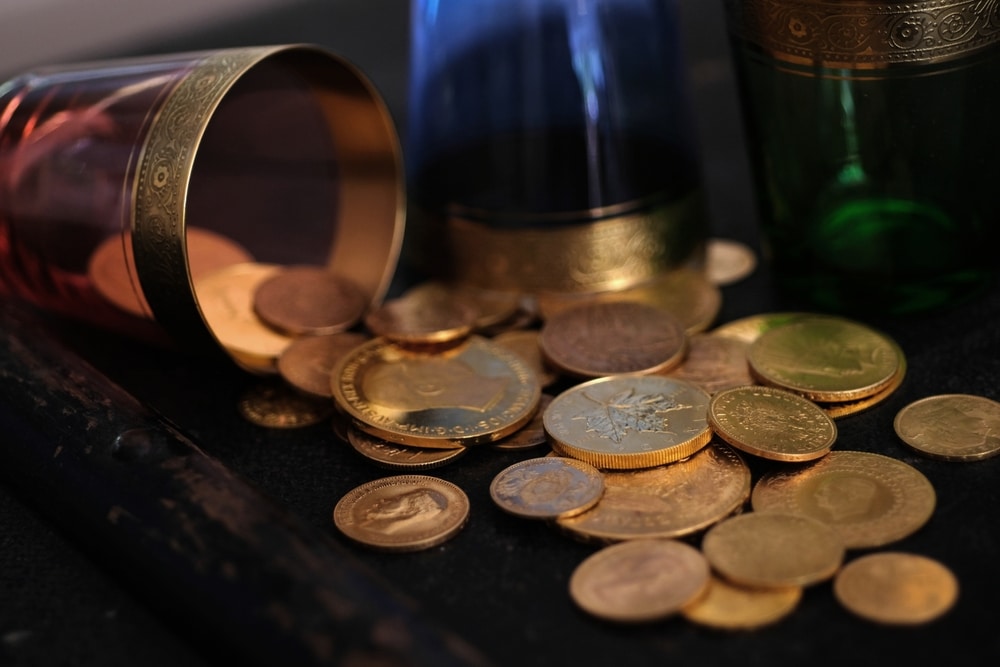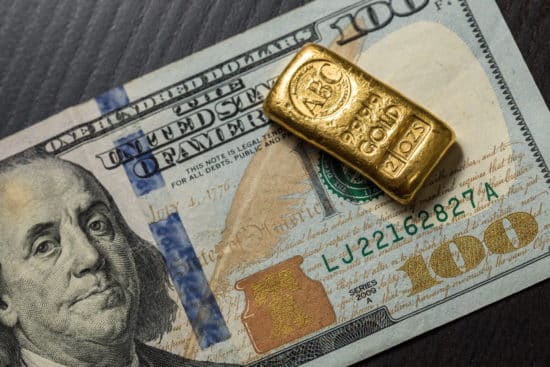Gold may not be a “relic,” but its history of use goes back to the dawn of civilization.
How far back, you ask? As far as its use as money, nearly three millennia, around 550 to 700 BC (the exact century is debatable). Lydian merchants were using gold as a medium of exchange.
But its use as a precious commodity goes back even further. The Egyptians used it to make jewelry around 3,600 BC. King Tut’s funeral mask is just one example of a highly-skilled gold craft. The Egyptians also learned how to alloy gold with other metals to create different colors and levels of hardness.
But, why gold among other metals?
It had unique properties. It was shiny. It was portable and divisible. It didn’t rust or corrode. It was malleable enough to create jewelry or make art. Later, it would be discovered that gold conducts heat and electricity, making it useful for various industrial purposes.
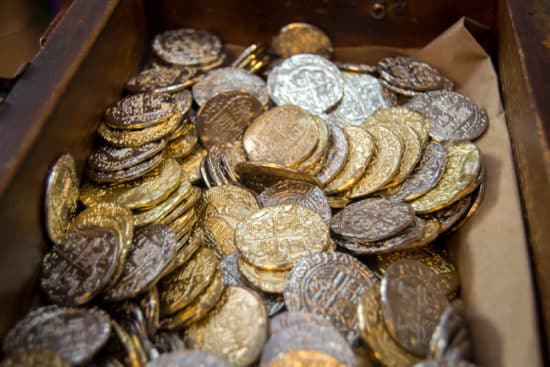
What other ancient civilizations used gold?
You’ll find evidence of gold used in the jewelry and artwork of civilizations in Meso-America, Mesopotamia, Egypt, Ancient China, India, Greece, and Rome.
Because of its beauty, rarity, and malleability, these civilizations found another use for gold: to press coins. In addition to these traits, gold coins were also portable and durable. So, why not use them as a medium of exchange, a unit of account, and a store of value? This is when gold became a currency.
When did monetary metals begin to emerge in ancient commerce?
History may date the use of gold as money around 550 to 700 BC, but the use of its counterpart in the “modern” gold standard—that is, silver—predates monetary gold.
The Sumerians began using silver as a monetary standard as early as 2,700 BC. In stark inversion to today’s view on gold and silver, the yellow metal actually took a back seat to silver.
Egypt began using standardized gold “rings” measured in weight as currency soon afterward. Both gold and silver were already in use as standardized currencies over 2,000 years prior to their monetary adoption in ancient Greece.
Ancient Rome gave monetary gold a boost as it employed the currency across its vast empire. It also advanced gold’s means of production, as Roman civilization under Julius Caesar invented the first hydraulic-based gold mining methods. Rome also developed the heating techniques necessary to derive gold from ore.
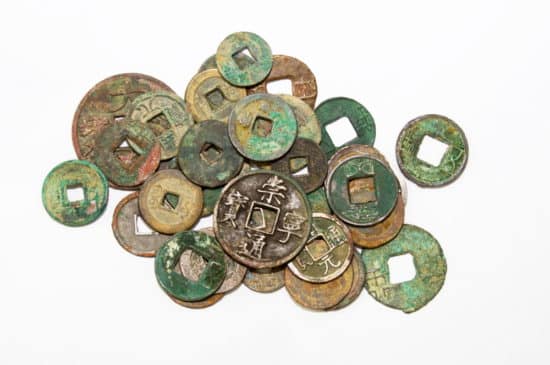
China started replacing hard currency with paper money during the Han Dynasty in 140BC
What about the use of paper money in ancient times?
China had been using paper currency since the Han Dynasty (140 BC). The Tang Dynasty (A.D. 618-907) further developed and scaled its use as a medium of exchange.
Why did China develop a paper money system? The answer is that it was much easier to transport; a necessity for mechants who often traveled long distances. If not for paper money, merchasts would have and to carry thousands of strings of coins, a practice that was neither safe nor efficient. So, the use of promissory notes were favored to physical coin transactions.
This, of course, had its problems. During the Song Dynasty (A.D. 960-1279) and the Mongol-held Yuan Dynasty (A.D. 1279-1368), there were several reissuances of paper currency due to overprinting, inflation, and hyperinflation.
Got it. So, does paper money always run the risk of eventual debasement?
As cited by Nathan Lewis in his book Gold: The FInal Standard, 14th-century Chinese historian Ma Twan-lin, he warned that…
“Paper should never be money (but) only employed as a representative sign of value existing in metals or produce … At first this was the mode in which paper currency was actually used among merchants. The government, borrowing this invention from private individuals, wished to a make a real money of paper, and thus the original contrivance was perverted.”
Lewis noted a historical pattern among countries adopting fiat in place of gold and silver. Most debased their currencies to oblivion. And we’re seeing this same pattern play out in the United States with the dollar debasing its purchasing power out of its nominal value.
What happened with the dollar-gold peg?
Although the US adopted a strict gold/silver standard as early as 1834, its functional origins preceding this date, it didn’t become official until 1900 when Congress passed the Gold Standard Act. Dollars were convertible to gold based on a fixed rate.
This convertibility ended in 1971. President Nixon effectively abolished the gold standard and gold, as well as dollars, was able to trade freely without a peg.
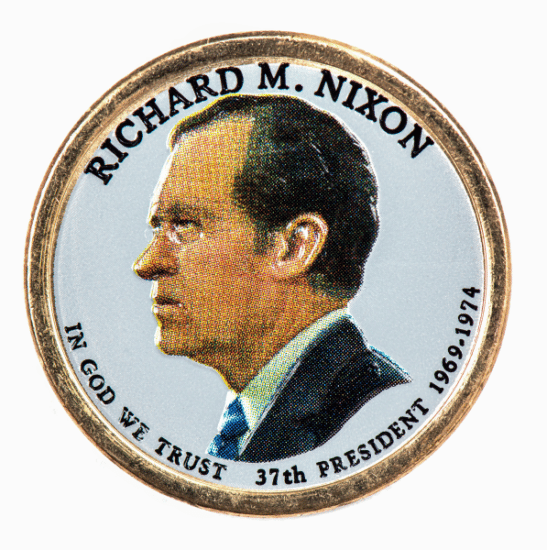
President Nixon effectively abolished the gold standard and gold in 1971
This leads us to where we are today. Most currencies are backed only by the government issuing them. This constitutes the “fiat currency system.” And like all fiat currencies across the globe, the US dollar has lost 86% of its purchasing power since the gold standard was abolished in 1971.
Interestingly enough, central banks continue to hold gold among their foreign exchange reserves. The Federal Reserve holds 6,700 tonnes of gold, according to World Gold Council estimates (though nearly half of what it held in 1973).
If gold prices fluctuate, isn’t it the same as any other investment?
This is where opinions and principles differ. To some investors, gold is just another investment. To others, gold is money itself; the source of value that gives any currency its “moneyness.”
These two notions of what gold really is aren’t necessarily compatible. Some would argue that gold’s “value” is not the same thing as gold’s “price.”
Dollar’s are subject to inflationary pressures as all fiat currency can be “printed,” it’s values manipulated. You can’t fabricate gold. It’s value is fixed at least in terms of its natural scarcity.
This is one reason why gold is viewed as an economic safe haven; a means to preserve wealth over time. And if we were to look at historical time as a criterion, gold’s value is written all over it.
Has gold ever been used to rescue an economy on the brink of collapse?
Yes. Safe passage out of Saigon in the 1970s depended on whether you owned gold or not. Argentina turned to gold when, in 1989, the cost of goods rose by 5,000%. When the Venezuelan bolivar collapsed, leading to hyperinflation, people used gold to buy food and other goods. Same thing in Zimbabwe, one of the most infamous examples of a hyperinflationary economy. Gold was bartered for food.
One of the most current examples of gold saving an economy is Russia. The country endured punishing sanctions when it annexed Crimea in 2014. Yet, it also built up its gold reserve worth around $140 billion.
Now with its war on Ukraine, its international trade with Western countries sanctioned, and its access to the SWIFT payment system cut off, Russia is using gold to support the value of the ruble.
If anything, these examples (and many others not mentioned) support the case that gold continues to play a prominent role in an economy, particularly under conditions of economic collapse.
What happened to the dollar after the gold standard?
The short answer is that the dollar lost 86% of its value since 1971. What costs us $1.00 now might have been bought for only 14 cents back in the early 1970s.
This is due to inflation, which is essentially the devaluation of the currency. Another classic inflation definition is “too much money chasing too few goods.”
As inflation rises, the “purchasing power” of a given currency (in our case, the US dollar) falls as the cost of goods rises. Unless your wages can rise at a rate that stays above the inflation rate, your buying will be reduced.
If inflation gets bad enough, might countries return to using a gold standard?
This is a tough question to answer, as each country would have its own way of resolving its currency or debt crisis.
For instance, Venezuela, a country that ended 2021 with a 686.4% hyperinflation rate, sold nearly half of its gold reserves for income and collateral for loans with international banks. What were a steady 300 tonnes in reserve is now at 162 tonnes.
After Russia’s invasion of Ukraine, western sanctions aimed at punishing the Russian economy were dampened by Russia’s deployment of gold reserves (worth an estimated $140 billion) to support its domestic currency, the ruble.
Central banks across the globe continue to hold gold among their foreign exchange reserves. If anything, this attests to gold’s active role in the global economy.
Might gold replace the dollar in the foreseeable future?
Unless most citizens across the globe along with American citizens lose all confidence in the US dollar, chances are that gold will not “replace” the dollar anytime soon.
But this doesn’t mean that gold won’t have an expanded legal tender status in the future, especially if the dollar continues to lose value (or the perception of value) in the eyes of the global markets.
Most importantly, physical gold remains attractive as an investment as well as a safe haven. Its value is recognized around the world. Also, gold carries no credit risk. This is especially true today, as the US economy is once again seeing a significant rise in inflation, one that’s outpacing wage growth for the average American household.
If gold continues to be a safe haven in times of inflation, war, political turmoil, geopolitical tensions, and overall economic uncertainty—in short, everything that’s happening today—then there’s no better time than now to invest in gold.


